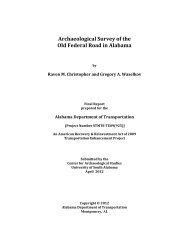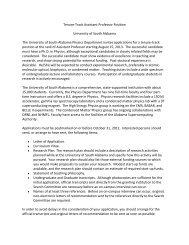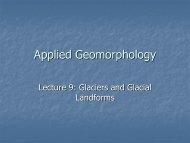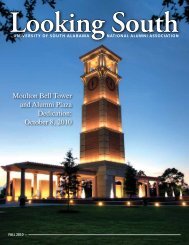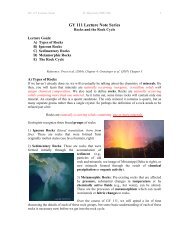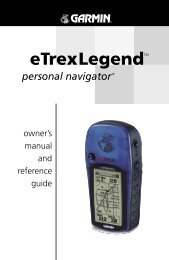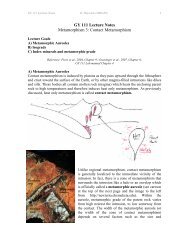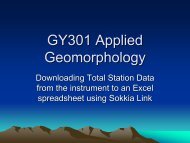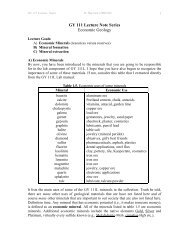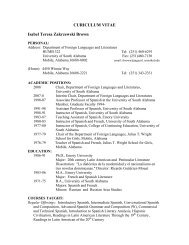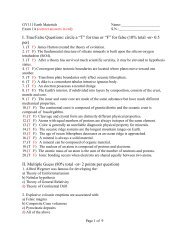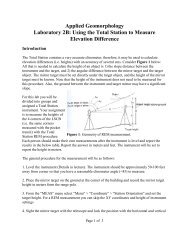GY403 Structural Geology
GY403 Structural Geology
GY403 Structural Geology
Create successful ePaper yourself
Turn your PDF publications into a flip-book with our unique Google optimized e-Paper software.
<strong>GY403</strong> <strong>Structural</strong><br />
<strong>Geology</strong><br />
Lecture 5: Descriptive Analysis- Analysis Field<br />
Mapping
Geological Field Mapping<br />
Note Keeping and Organization<br />
Outcrop Descriptions<br />
Components of a Geologic Map<br />
Components of a Geologic Map<br />
Geological Contacts<br />
Geological Contacts<br />
Primary Contacts<br />
Primary Contacts<br />
Depositional<br />
Unconformable<br />
Intrusive<br />
Secondary Contacts<br />
Secondary Contacts<br />
Fault Contacts<br />
Fault Contacts<br />
Shear Zones<br />
Primary Structures<br />
Structure Contours
Notes must correlate<br />
with map/GPS stations<br />
All measured structures<br />
must be recorded for<br />
later stereographic<br />
analysis<br />
Photos must be indexed<br />
by map station<br />
Rock/Mineral samples<br />
must be indexed by<br />
station ID<br />
Field Notes
Where needed<br />
sketches of outcrops<br />
should be included to<br />
clarify notes<br />
Note Sketches
Rock Descriptions at a Map Station<br />
Rock Name: Igneous, Sedimentary or Metamorphic<br />
classification<br />
Color<br />
Mineralogy<br />
Texture<br />
Primary Features (ripples, cross-bedding, cross bedding, vesicles, etc.)<br />
Gross characteristics (weathering, ridge-former)<br />
ridge former)<br />
Formation name and age (if known)<br />
Contacts present in outcrop
Components of a Geologic Map<br />
Explanation<br />
Describes uses of structure symbols (bedding, lineation, etc.)<br />
Lithologic Column: chronologic order of formations (young<br />
on top) and lithologic symbols (sandstone, limestone, etc.)<br />
Linework (fault, depositional, unconformable contacts)<br />
Title (includes geographic location)<br />
North Arrow (geographic and magnetic)<br />
Scale (RF and graphical)<br />
Border (bounding latitude and longitude of map area)<br />
Authorship and Date of completion
Geologic Map Template<br />
Includes the<br />
components of a<br />
complete<br />
geologic map
Conformable<br />
Depositional Contacts<br />
Mapping Contacts<br />
Bedding contacts<br />
represent changes in<br />
depositional environment<br />
Time gap represented by<br />
contact (Diastem) is<br />
short by geological<br />
standards
Unconformity: a depositional<br />
surface produced by erosion<br />
and/or periods of non-deposition<br />
non deposition<br />
Angular Unconformity<br />
Tilted strata below unconformity<br />
surface<br />
Disconformity<br />
Strata is parallel to unconformity<br />
above and below unconformable<br />
contact<br />
Nonconformity<br />
Rocks below unconformable<br />
contact can be demonstrated to<br />
have been uplifted and eroded<br />
from great depth<br />
Unconformities
Angular Unconformity Example<br />
A period of<br />
deformation<br />
preceded uplift and<br />
erosion<br />
Older units below<br />
unconformity<br />
display truncation<br />
by unconformable<br />
contact<br />
Tapeats Sandstone Fm. (C)<br />
Grand Canyon<br />
Series Fm. (pC)
Disconformity Example<br />
Usually based on paleontological data since it is<br />
difficult to recognize in the field<br />
Redwall Ls. (M)<br />
Muav Ls. (C)<br />
Disconformity
Nonconformity Example<br />
Rocks below unconformable surface have been<br />
deeply eroded into and brought from great<br />
depth to the surface<br />
Cap Mt. Limestone (500 Ma)<br />
Town Mt. Granite (1.0 Ga)<br />
Nonconformity
Confusing Faults with<br />
Unconformities<br />
Unconformities may be confused with fault contacts<br />
since both truncate contacts. Remember that a fault<br />
generally truncates strata on both sides of the contact<br />
Strata younger than the unconformity generally (but not<br />
always- always see Buttress unconformity) will be parallel to<br />
the unconformity<br />
An unconformable contact may display evidence of<br />
paleo-erosion paleo erosion (soil profiles, topographic relief, worm<br />
burrows, etc.)<br />
Low-angle Low angle regional unconformities are impossible to<br />
recognize at a single outcrop
Buttress Unconformity<br />
Younger strata is<br />
actually truncated<br />
by erosional<br />
surface- surface this<br />
scenario is<br />
generated by<br />
active normal<br />
fault motion
Low-Angle Low Angle Regional Unconformity<br />
Recognition of low-angle low angle<br />
unconformity requires<br />
measured sections at<br />
many exposures
Intrusive Contacts<br />
Produced by the intrusion of magma or some<br />
other liquid (hydrothermal, salt, etc.)<br />
Intrusions of magma often produce xenoliths-<br />
portions of the country rock that are stoped into<br />
the magma and remain recognizable after<br />
crystallization of the magma<br />
Pendants are similar to xenoliths but retain a<br />
physical connection to the country rock
Intrusive Contacts: Xenoliths<br />
Xenoliths are<br />
portions of the<br />
surrounding<br />
country rock that<br />
fall into the<br />
magma chamber.<br />
If they do not<br />
completely melt<br />
these blocks are<br />
preserved as<br />
xenoliths and<br />
they prove the<br />
intrusive nature<br />
of the igneous<br />
rock.
Intrusive Geometry<br />
Discordant: cuts across country rock bedding and/or fabric.<br />
Batholiths: > 100 km2 outcrop area<br />
Stock: 100-1 100 1 km2 outcrop area<br />
Pluton: < 1 km2 outcrop area<br />
Dike: tabular<br />
Discordant: cuts across country rock bedding and/or fabric.<br />
Concordant: intrudes parallel to country rock bedding and/or<br />
fabric<br />
Sill: tabular<br />
Laccolith: flat bottom, concave down upper contact, low viscosity viscosit<br />
Lopolith: flat top, concave up bottom contact, mafic batholith
Intrusive Geometry cont.
Non-magmatic Non magmatic Intrusions<br />
Clastic dikes: intrusions<br />
of water-oversaturated<br />
water oversaturated<br />
clastic sediments that<br />
intrude older rocks along<br />
fractures
Anhydrite,<br />
Gypsum<br />
and Halite:<br />
extremely<br />
ductile<br />
under<br />
even<br />
moderately<br />
elevated T<br />
& P<br />
Salt Diapirs
Fault Contacts<br />
Cataclastic Rocks: produced by the grinding action in<br />
the fault zone<br />
Fault Gouge: fine powder<br />
Fault Breccia: angular fragments that are bound together by a<br />
fine-grained fine grained matrix of pulverized material<br />
Slickensides<br />
Mylonites<br />
Drag Folding<br />
Ductile Shear Zones
Fault Breccia Example<br />
Angular fragments floating in a fine-grained fine grained matrix
Primary Structures: may provide<br />
“younging younging” direction<br />
Bedding (does not provide younging direction)<br />
Cross-bedding<br />
Cross bedding<br />
Graded beds<br />
Ripple marks (symmetrical = younging direction)<br />
Mud cracks<br />
Sole marks<br />
Pillow structure<br />
Vesicular lava flows<br />
Fractional crystallization
Bedding Example<br />
Bedding represents changes in depositional<br />
environments separated by short intervals of time
Cross-bedding<br />
Cross bedding<br />
Truncation occurs on upper portion of bed;<br />
younging direction is on concave side of cross-<br />
bedding
Coarse<br />
material is<br />
deposited at<br />
base of bed;<br />
fine material<br />
at the top of<br />
the bed<br />
Graded Beds
2 basic types:<br />
Ripple Marks<br />
Asymmetric = unidirectional flow<br />
Symmetrical = bi-directional bi directional flow<br />
Symmetrical = younging direction<br />
Shallow slope faces source of flow
Mud Cracks<br />
Concave toward original<br />
to of bed
Sole Marks<br />
Mold made by upper unit extends into older<br />
weathered unit, therefore, sole marks exist on<br />
the base (lower original contact) of a bed
Pillow Structure<br />
Pillow basalts form an original “concave concave down” down<br />
type structure
Vesicular Lava Flow<br />
Vesicles (gas bubbles) are trapped near the top<br />
of the lava flow
Fractional Crystallization<br />
Ultramafic and mafic layers occur at the original<br />
base of a layered intrusion, intermediate and<br />
felsic units near the top.
<strong>Structural</strong> Contours<br />
Contour lines depicting the elevation of a<br />
contact in the in the subsurface: Isolith map<br />
Contour lines depicting the thickness of a unit in<br />
the subsurface: Isopach map<br />
Adjacent contours may be used to estimate the<br />
strike & dip or bearing & plunge of planes and<br />
lines at any point on a isolith map
Estimating Strike & Dip<br />
The trend of the contour line determines the strike, the<br />
dip is calculated perpendicular to strike using the<br />
elevation change of adjacent contour lines<br />
N60W<br />
51<br />
B<br />
A<br />
-1200<br />
80 ft.<br />
51<br />
-1300<br />
43<br />
-1400<br />
-1500<br />
45<br />
45<br />
A<br />
80 ft.<br />
100 ft.<br />
B<br />
Dip = ArcTan(100/80)=51
Structure Contours & Faults<br />
The effects of faulting are often evident in<br />
isolith maps<br />
-7000ft<br />
-5000ft<br />
-6000ft<br />
A<br />
B<br />
Scale (feet)<br />
0 1000 2000<br />
-5000ft<br />
-6000ft<br />
-3000ft<br />
-4000ft<br />
-2000ft<br />
N
Solving for the Attitude of the Fault<br />
Equivalent contours are found in separate fault blocks-<br />
the strike of the fault is the connecting contour line<br />
-7000ft<br />
-5000ft<br />
-6000ft<br />
A<br />
B<br />
900<br />
C<br />
600<br />
Dip of Bedding = ArcTan(1000/900)=48 South<br />
Dip of Fault = ArcTan(1000/600) = 59 NW<br />
D<br />
N20E<br />
Scale (feet)<br />
0 1000 2000<br />
-5000ft<br />
-6000ft<br />
-3000ft<br />
-4000ft<br />
-2000ft<br />
N
Exam 1 Summary<br />
Be able to discuss the various types of contacts and how they may may<br />
be recognized in the field:<br />
Depositional<br />
Intrusive<br />
Unconformable<br />
Angular<br />
Disconformable<br />
Nonconformable<br />
Faulted (including fault zone rocks: gouge, breccia, mylonite)<br />
Be able to sketch and define intrusive geometry<br />
Be able to discuss the required components of a geologic map<br />
Be able to discuss and sketch the various types of primary features features<br />
that indicate a facing direction<br />
Be able to interpret structure contour maps<br />
Be able to discuss detailed structural analysis (Descriptive, Kinematic, Kinematic,<br />
Dynamic, Tectonic)<br />
Be able to discuss the components of Kinematic analysis (translation, (translation,<br />
rotation, dilation, distortion)<br />
and give geological examples of each<br />
Know the geologic time scale




